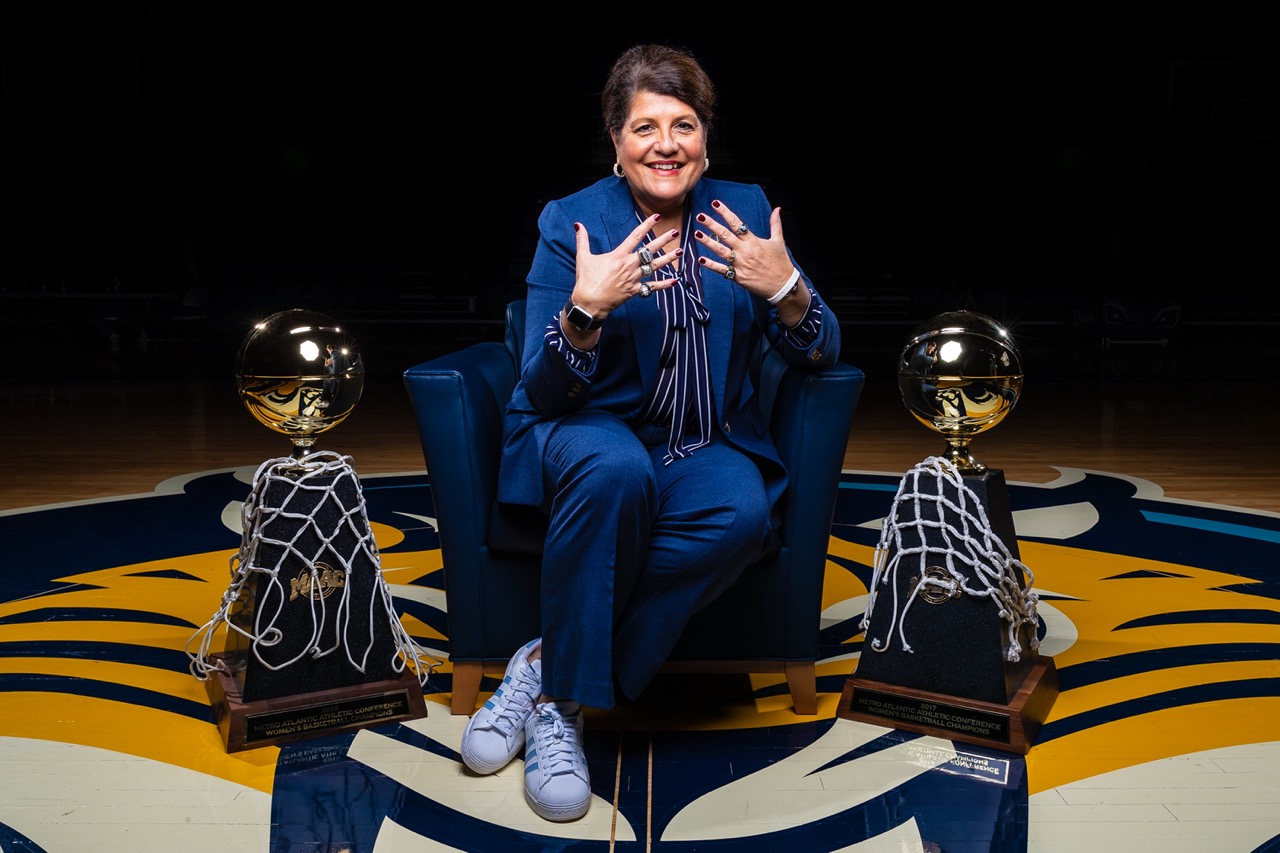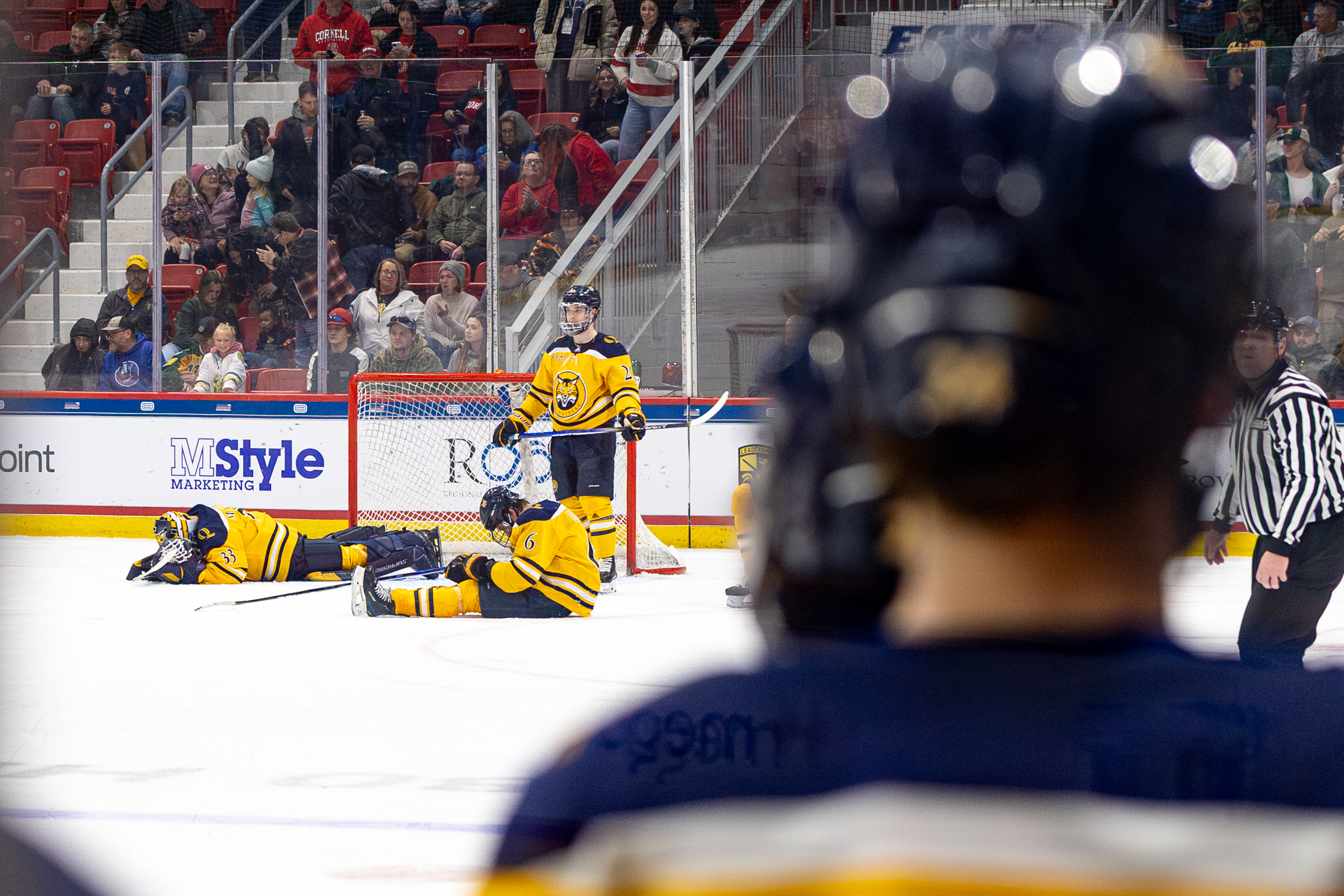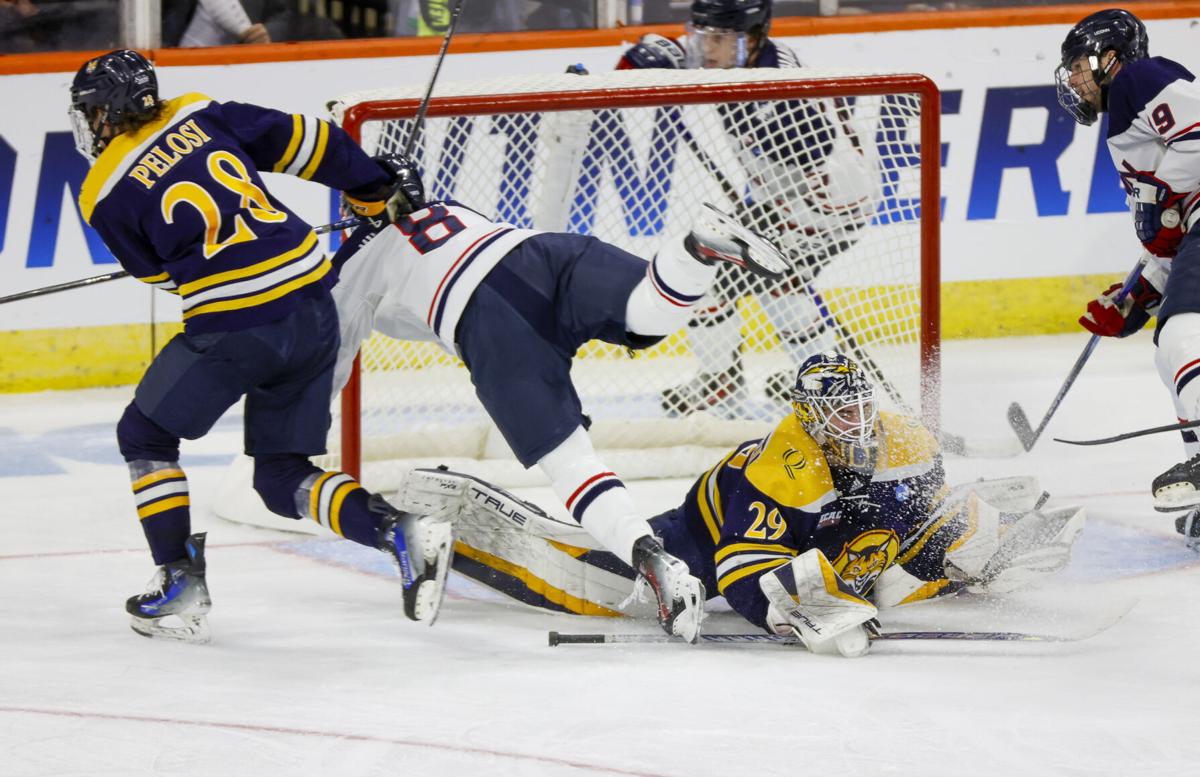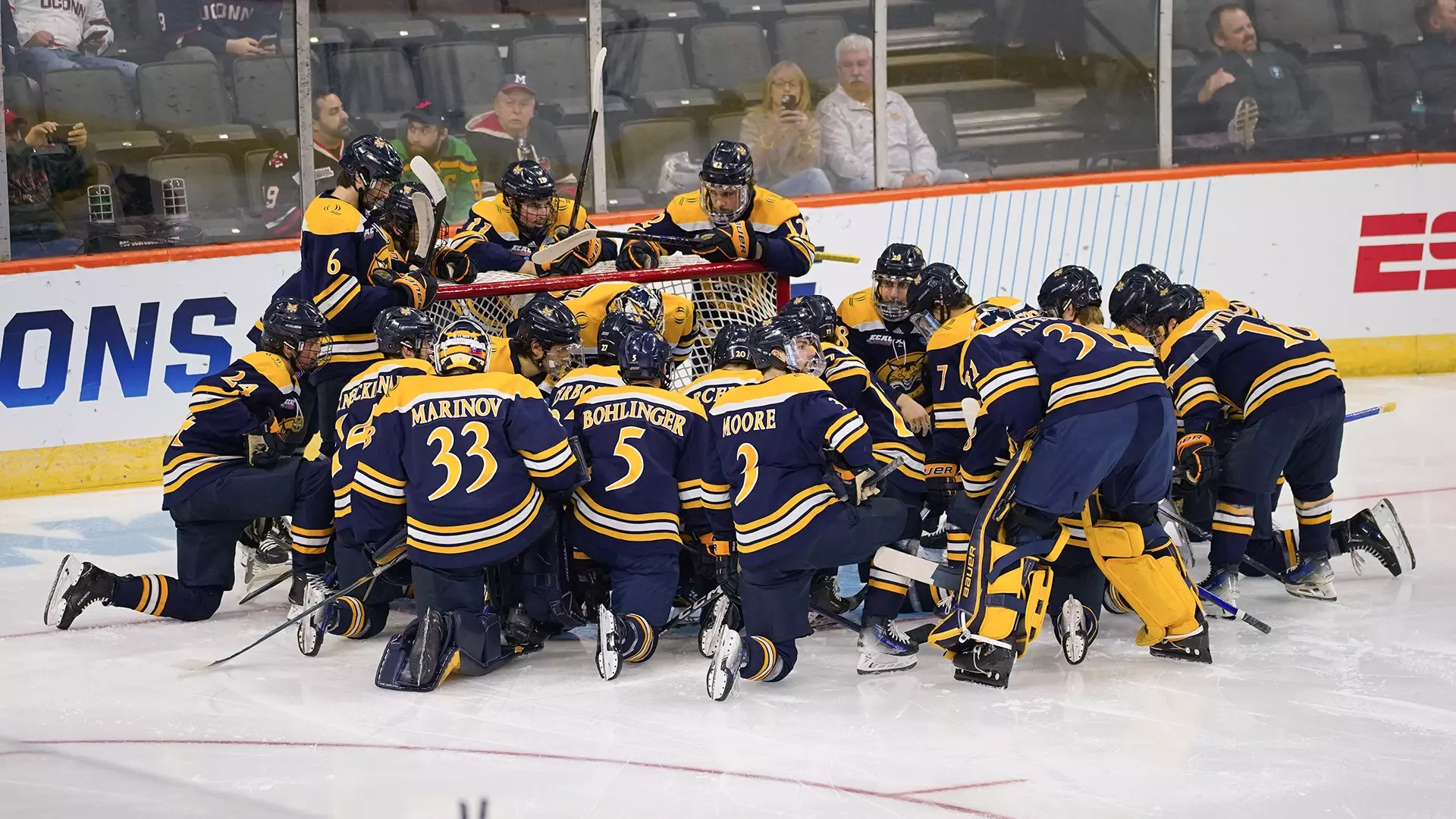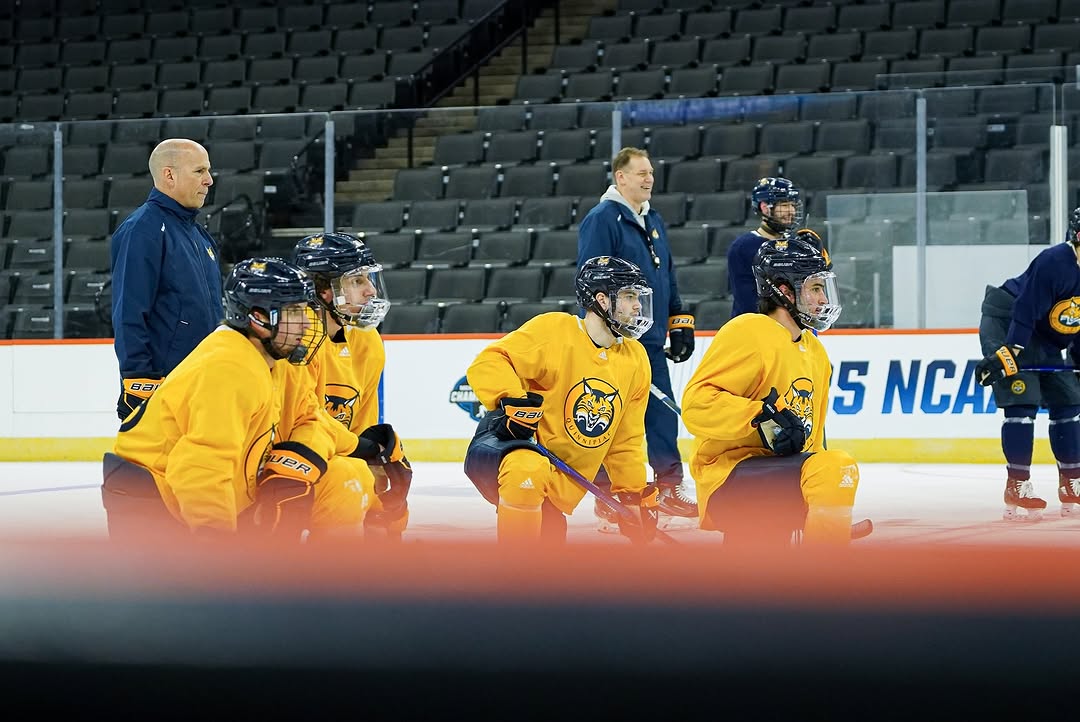By: Connor Coar and Toni Wetmore
Hamden, CT – Tricia Fabbri was hired as Quinnipiac College’s first full-time women’s basketball coach in 1995.
She did not have an arena to call home like she does now. Her resources — as a Division II school in the mid-1990s — were limited. She didn’t even have an office to herself.
Coming from Fairfield University, Fabbri had a stellar playing career. Known then by her maiden name, Tricia Sacca, she finished her career with 1,622 points, 1,036 rebounds and three First-Team All-Conference selections. Fabbri knew what winning looked, felt and sounded like early in her life.
Fabbri wasn’t coaching when she got a call from her former coach at Fairfield, Dianne Nolan, asking her to join her coaching staff as an assistant after graduating.
Fabbri was working as a cocktail waitress in Atlantic City when Nolan called her back to Connecticut.
As an assistant for four seasons, Fabbri helped the Stags to a record of 64-51. Once Quinnipiac had an opening for its head women’s basketball coaching position, then athletic director Burt Kahn reached out to Fabbri about moving to Quinnipiac.
This article is a profile of Fabbri’s 30 years in Hamden (on and off the court) told by her peers, players, assistant coaches, family and all those who became family along the way.
Early Days
Nolan: “It also made a lot of sense. They were just getting their program off the ground. [Fairfield] at the time had done a similar thing. We went from Division II to Division I. We had made the NCAA Tournament a few times. I think the administration at Quinnipiac looked at Fairfield and said, ‘Wow. We want to kind of do what they did,’ and she is all part of that. Let’s hire someone who’s been through it and has had success with it.”
John Lahey, Quinnipiac President 1987-2018: “She was very young … And I’ll have to give Burt Kahn credit … He recognized the quality and potential there to hire [a] younger coach.”
Billy Mecca, Quinnipiac MBB Coach 1991-96/Senior Associate Athletic Director 1998-Present: “She was full of energy and a bundle of joy. And really anxious in a good way, about the opportunity that Quinnipiac provided for her.”
Lahey: “You hire young leaders and you hope they’ll turn out to be great, but you never know for sure. So, whatever Trish has, I wish I could clone it. I wish I could have every coach that we hired turn into a Trish Sacca. You know, she’s very impressive. She’s a big woman. I mean, she’s a presence. I can only imagine her boxing somebody out. I see why she had the rebounding records.”
Fabbri had the potential to be a great coach, and 30 years later many can attest she’s achieved that status. It wasn’t always that way, though.
After a 33-98 record in her first five seasons in Hamden, frustration weighed heavily on Fabbri. Her story at Quinnipiac almost ended before it really even started.
Nolan: “I don’t think she ever shared this story that she was ready to resign. Her first few years were not successful and nor were mine at Fairfield … She hates to lose and the losing killed her.”
Mecca: “She just wanted to walk away because she was so competitive, and winning was such a part of the institution of the Sacca name, that her not winning (was) what she would call failing … But her ability to get past that and use it as a springboard, to me it’s a remarkable story of perseverance.”
Nolan: “When you lose as a coach, self doubt creeps in. No matter what anybody says, you are what your baseball card reads. So it was hard, but we knew she had it. The school was on the right path. It was just going to take time.”
Who is Coach Fabbri?
Whether it’s from playing for her or working alongside her, there are many ways to describe Fabbri on the court and around the game of basketball. Her success at QU came once she started to find her footing in recruiting.
Mecca: “Her ability to get kids committed versus her grabbing kids just to be involved, that’s when you saw the transition from being an average basketball team to the powerhouse she created.”
Nolan: “Winning breeds winning. When you win a championship, you can go get a higher level recruit and it kind of snowballs.”
Greg Amodio, Quinnipiac Athletic Director 2015-Present: “She finds kids that fit into her program and will work with her mindset. And then there’s a level of expectation that is within the entire program that we’re not just here to be mediocre, we’re here to try to compete for championships.”
Nolan: “When you win your first conference championship, it’s hard to do … Once you win one, it’s very addicting. Us coaches all have addictive personalities. Thank God we coach. We don’t gamble.”

Amodio: “With success comes other eyes on your program and on your coach … Am I going to get a phone call? Is Trish going to get a phone call? And there were phone calls. Those coaches who get phone calls from other schools about an opportunity to move up just means that they’ve been doing a really good job where you are … [With] Dr. Lahey, who was here at the time, we were incredibly proactive in rewarding Tricia for her success and showing her that she was important to us.”
Fabbri’s precision and honesty keeps her atop the game and helps her earn respect from her players and staff.
Gillian “Boo” Abshire, Quinnipiac Guard 2011-15: “She’s all about the details and going the extra mile, and I really think that’s what makes her so great is just paying attention to those details – showing love and passion every single day, and she’s really just the best human out there.”
Lisa Lebak, Quinnipiac Guard 2009-13: “She’s willing to call you out for your mess ups, but she’s willing to do the same for herself, and have ownership in what she may have or could have done better or differently.”
Pat Kraemer, Quinnipiac SID 2023-Present: “She doesn’t even tell [the players] how to fix [anything]. She just expects them to know how to fix it and how to change their attitude, their effort, whatever it is. She’ll just say out loud ‘I don’t like our effort.’ She’ll just be brutally honest with them. She doesn’t tell them how to fix anything. They just already know.”
Mackenzie DeWees, Quinnipiac Guard 2018-23: “It can sound harsh sometimes, but Coach is just preparing you for life. There’s obstacles that we face. There’s mistakes that we make and you have to pick back up and readjust and keep going.”
Amodio: “I think the thing I love about her is there’s no nonsense. There’s not a lot of drama with her program and with her, she holds her student athletes accountable.”
Jasmine Martin, Quinnipiac Guard 2011-15: “She loves her players, she loves coaching, she loves what she does, and she shows up for us 110% every day. In all my years playing, I never felt like ‘Man, she doesn’t want to be here’, or ‘It’s just too much for her.’”
Abshire: “And obviously being a Division I athlete is really tough, but you have this female coach who’s been in my shoes before. So it’s just like, why wouldn’t I listen to every single word that she says?”
Lori Landino, Men’s & Women’s Basketball Administrative Assistant 2007-Present: “Her success is different, but it’s also what she does every day to come to the table – to how she’s prepared, how she prepares along the way and all the little details how she handles her business to get to the final point.”
Mountain MacGillivray, Quinnipiac Assistant 2009-18: “Coach is utterly unflappable and just ready to go. When we were playing a game where we were supposed to win, she was always a nervous wreck. Because she never liked being in a situation where we had a big lead, so … It allowed me and the assistants to be assistants, and kind of took her off the ledge when we had already done our job and put a team away, we could try to get her to calm down.”

Jen Fay, Quinnipiac Forward 2014-19: “I would say she’s demanding, but in the best way possible.”
DeWees: “When I was a freshman and we had been losing at halftime to Harvard, I remember she came into the locker room and it was like [this] fire in her eyes. I felt like she had fire in her eyes and fire in her hair, and instead of being shocked, everybody just honed in … Some people misinterpret it for being angry, how her demeanor and stuff are being angry or mad. It’s not, she’s just a passionate, caring woman that wants to win games and wants to play basketball.”
Lebak: “She told you what she needed from you, and there were no secrets or confusion whatsoever. I think direct is probably the best thing you can be as a coach, and she absolutely was, which was super helpful.”
Carly Fabbri, Daughter/Quinnipiac Guard 2014-18: “I think that’s why she’s made such a niche for her in this career. I just think that kind of trickles down throughout her players and her best players are normally the ones that are really tough-nosed, really competitive, will outwork you, and I think that’s her coaching style as well.”
An example of this tough-nosed nature comes from Jen Fay needing a “gentle” reminder on the bench during a game.
Fay: “We’re at Marist and I think it’s my senior year. I’m absolutely playing terribly. She pulls me out, she turns to me and goes, ‘Are you ready to get your head out of your ass now? You ready to go play?’ In that moment I was like, ‘I love you.’ It was like ‘Yeah, you’re right. You’re exactly right.’”
Fabbri is transparent with who she is from the minute players she is recruiting step onto Quinnipiac’s campus.
Martin: “A lot of times you get recruited, it ends up being the people who recruited you aren’t the people who actually are coaching you. It’s a facade. I didn’t know what I was getting into. But with Coach, my dad always said, ‘Go where you’re loved, not where you’re liked,’ and Coach showed that she loved me.”
Jacinda Dunbar, Quinnipiac Forward 2008-2012: “I’d never even heard of the school Quinnipiac until I was being recruited … But the one thing I can remember about her that made me comfortable was just more or less just the warmth that she just has, whether she knows you for a long time, whether you’re brand new, it’s always consistent and it’s always inviting.”
Fay: “I remember driving up this huge hill. I’m like, where am I going? I was an hour and a half away. Her and Mountain both recruited me heavily out of New York City. And I remember on my visit, just kind of getting out of the car. As soon as I got out of the car, the energy and the passion were just right there.”
Kraemer: “That’s a big way that Trish sells this place, is just being comfortable from the minute you step foot on campus.”
AJ Fabbri, Son: “I think my mom is really a salt of the earth woman. I think that’s why a lot of young women want to come play for her, because she can relate to a lot of different people from a lot of different walks of life.”
Fay: “My gratitude for her now is 10 times what it was as a player. I had no idea the behind-the-scenes stuff that you have to go through as a head coach and the decisions you have to make, trying to keep everybody happy. It’s incredible how much she can juggle.”
Her ability to recruit highly competitive players got the team its first NCAA Tournament win in 2017. Fabbri’s message to the team before the game still stays with her players to this day.
Carly Fabbri: “We were super dialed in … Fired up just to be in Miami, to be in the tournament. Sometimes you can get a little bit wrapped up, but I thought her and the rest of the coaching staff did such a great job of grounding us and making sure that we were so well prepared. She ended [practice] with ‘And when we win tomorrow, be ready, don’t act like you’ve never been there before, even though you really haven’t, but act like you deserve this and you’ve been prepared.’”
Every year, only a small number of teams end their season with a win, and everyone else has to end their season with a loss. Fabbri has had to address her teams in painful moments, including ones like the end of a season.
Amodio: “In the face of defeat, she still has an even keel about her. She’s as pissed off as anybody, but she can compartmentalize that and still bring it around to a positive message.”
Kraemer: “Probably one of the biggest losses we had this year was in the MAAC Championship. She didn’t even talk about the game afterwards. She said, ‘I don’t care about the game. We had a great season.’”
DeWees: “Once you’re in her group, she loves you like you’re one of her kids.”
Landino: “She stands the test of time.”
Who is Tricia Fabbri The Person?
Fabbri has 544 wins on her resume. It’s easy to talk about her as a coach and the success she has had, but it’s who she is off the court that has stayed with people the most.
Mecca: “Her personality has never changed. Her personality had the ability to open doors back then, but over time, the character that she developed kept every door open.”
Abshire: “One of my favorite things about her is she’s not afraid to show her emotions. I have countless memories of her getting choked up in a locker room because of how much she cares.”
Landino: “She wears her heart on her sleeve. Her vulnerability and her emotion, it’s so true.”
MacGillivray: “She also was not afraid to let the players see how much she cared. She wouldn’t hesitate to cry, she wouldn’t hesitate to show her emotions if the frustration got to a point where she was pouring herself out, and she didn’t feel like the team was… She wasn’t afraid to show it, and I think that vulnerability draws the players to be connected to their coach, and I think honestly to this day I still wish I had a little bit more of that.”

Fay: “Her ability to know what kind of message and tone needs to be said to the team at what point during the game and her ability to push the assistant (coaches) and really be emotional, but then know that, ‘okay, the kids need confidence right now.’”
Abshire: “I remember when I did my first scout. It’s kind of like a big project you do. You work on it for a lot of hours and then deliver it to the team. I texted her that morning and just told her that I was nervous. And she was like, ‘You know what, Boo? Why don’t you just share with your team that you’re nervous? Like, it’s okay to be vulnerable.’”
Fay: “It allows her to be demanding on the court because you know how much she cares about you off the court. But the way that Coach treats (people) from the custodian who’s vacuuming the locker room, to her best player to her assistant coaches, it doesn’t change.”
Becky Mella, Senior Associate Athletic Trainer 2011-Present: Even when there’s tons of injuries, that can be stressful, because it takes away their plan, right? Takes away their power a little bit, not on purpose, but, she’s just always so good. She’ll get stressed at times, but she’ll always come back and thank me. She always says the nicest things to basically appreciate us as a staff and what we do. We’re all on the same page, so that’s all you need really.
Fabbri even embraces her players and staff by opening up her home to them.
Fay: “She would have the team over all the time. Even those players like us, who couldn’t go home, ‘Come over for a meal, come over and do this and that.’”
Martin: “I was in Boston maybe, like I don’t know, 4 or 5 months ago I needed a place to stay on my way home, and she let (me stay). Her door is always open.”
MacGillivray: “She’s just a really enjoyable person to be around, she knows how to have fun, and she sure knows how to host a party like nobody’s business.”
And while she is a fierce competitor on the court, she has a fun, goofy side that she’s not afraid to show too.
Lebak: “I think one of my favorite things about Coach Fabbri is every now and then she would come in and we would finish practice, and we’d be in a circle, and she’d just start dancing. Like, where is this coming from?”
Nolan: “(My husband) had this one saying about her. ‘Sacca does everything large.’ She had big hair, she had a big car. That’s what made her fun. She did everything with great enthusiasm and great competitiveness.”
Paul Henry Fabbri, Son: “There’s a reason why girls come back with their kids and their families for the alumni weekend. Come see Coach Fabbri, and that’s most rewarding, being able to talk to all of them, whether it’s from 1999 or 2014. Girls are coming back.”
What Was Your First Impression of Fabbri?
Cass Turner, Women’s Ice Hockey Head Coach (2015-Present): “I think every interaction I ever had with Coach Fabbri has been an energetic one. I feel like I can remember first meeting her and just instantly knowing (she) was somebody who was successful, and that I (could) turn to when I needed to and (someone) to look up to as a great mentor in coaching.”
Tyrell Walden-Martin, Sports Information Director 2021-2023: “My first interaction with her was when they won the championship my freshman year. The entire crowd rushed the floor and everybody stormed the court … And as I was celebrating on the court I just bumped into Trish. But I saw Trish and I was just like, ‘Congratulations, Coach’ and she just gave me a hug. At the time I’m just a random student so I’m just like, holy crap. I just hugged the women’s basketball head coach (who) just won a championship on our floor.”
Tyler Brosious, Women’s Basketball Graduate Assistant (2017-18): “Everyone was always like, ‘You’re from South Jersey. Trish is from South Jersey. You guys have to go talk to each other.’ We found out that she is from the exact town where my dad was living at the time. Where she grew up and where I grew up was like a 10 minute drive. We were truly cut from the same cloth. There was an instant connection there that blossomed in the four or five years that we worked together.”
Abshire: “The morning of my (recruiting) visit, I remember (there was) something that paralleled to my mom. She walked up and introduced herself to me and she had her Starbucks cup, and it had red lipstick all over the part where you drink, and that’s the same thing as my mom. So that was a big reason why — I know it’s something so small and corny – but I was like, ‘I think I’m going to come here.’”
MacGillivray: “I went to main campus first, walked down to the center of the quad, didn’t know where the arena or the gym was. [I] looked back, saw Sleeping Giant over the dome of the business school and was like, ‘Yeah, I could get used to this.’ I was like ‘Man, I think I could talk anyone into coming here.’ So that was certainly a big sell.”
Brijesh Patel, Associate Athletic Director/Director of Athletic Performance (2008-Present): “Quinnipiac didn’t really have a strength coach before me … But right from the get go, I explained ‘Here’s the philosophy, here’s how we’re gonna do things.’ And she was like, ‘I’m all in. Let’s go.’ So it was fantastic to have that level of support initially, when you’re working with somebody for the first time.”
Mom Fabbri
When asked to describe Fabbri, “motherly” was used by almost every person, whether they played for her or worked with her. Her own children grew up at Quinnipiac as part of the team, accepting their “extra siblings” with open arms.
Fabbri’s oldest son, AJ, has one of his earliest memories at a Quinnipiac game.
AJ Fabbri: “When my mom was first starting out coaching, apparently (the other team) was on a fast break. I got loose from whoever was watching me and ran out onto the court and the game had to get stopped. They got delayed, the refs blew a whistle, all that. I saw my mom and just took off right in the middle of the game. My mom always gave me credit for saving a bucket for her on defense because I was able to stop a fast break as a five or six year old.”
And even with the demanding nature of running a basketball program, Fabbri went out of her way to make time for her own kids as they grew up.
Paul Henry Fabbri: “(During) my senior year of high school basketball she was scheduling practices around my schedule because she was like, ‘I am not missing any of your games.’ I was the last kid who was still playing, and I was having a really great year. But it’s so funny because she was so cool and tame in the stands. (She had) that different side of her being the intense coach on the sidelines, and then coming to her kid’s game and just sitting there waiting and never getting really too crazy.”
Her ability to have the same level of care for her bloodline and her “adopted family” is unwavering.
Fay: “That is my mom away from home. Her ability to push and to maximize potential and all of her players and at the same time to put an arm around them is incredible.”
AJ Fabbri: “It’s very gratifying to hear other players view my mom as a mother figure. That’s just the type of woman she is. I just think that that speaks to her character so much.”
AJ Fabbri: “As a young man growing up in today’s day and age, I just feel very grateful to have such a strong, brave and courageous female role model in my life. For me, it was never men’s basketball or women’s basketball. Basketball was basketball because in our household, it didn’t matter.”
While Fabbri’s daughter, Carly, eventually joined the team as a player, she was always involved with the program in some way from a very young age.
Carly Fabbri: Being on the bench (growing up) and seeing how the coaches acted, how the players acted. That was such an advantage for me. To be able to be like, ‘Okay, even if you have a bad play and you get subbed out, this is how you should act. You should just go to the bench, you shouldn’t hang your head.’ And just being around that at such an impressionable age … Taught me right from wrong.”
MacGillivray: “It felt like Carly was part of the team long before she started playing. She was there handing out the water and on the bench waving the towel long before her playing years, so it just seemed like a natural transition.”
Carly Fabbri: “I was a water girl. I took that job very seriously. I knew which girls wanted Gatorade, which girls wanted water, which girls needed an extra cup for whatever reason.”
Trica and Carly Fabbri’s dynamic changed from mother/daughter to coach/player as well in 2014.
Nolan: “I remember when she was going to coach Carly… I remember her calling Kim Mulkey and Chris Gobrecht (to ask) what it’s like having to coach your daughter. She had a couple role models there.”
AJ Fabbri: “I think my mom kind of wanted to be hands off and let Carly have her own college experience with it.”
Carly Fabbri: “I feel like we did a good job of keeping it relatively normal. I wouldn’t really call her mom on the court, she was always Coach on the court.”
Abshire: “Carly earned every single minute that she played. If you wanted me to print out a teammate being the perfect teammate, it would be Carly Fabbri, in every way that year.”
Carly Fabbri’s Quinnipiac playing career ended in Connecticut in the second round of the 2018 NCAA Tournament. The cheers from her home state fans roared as she and her mom embraced in a quick hug for their final moment as coach and daughter.

Carly Fabbri: “(For my last game) to be up there at Gampel (Pavillion) and playing in front of 10,000 people with Geno Auriemma, and for that to how my college career ended… If I had to lose, it might as well be to UConn and in that kind of environment. But then obviously doing it with my mom it literally was like a storybook.”
Lahey: “I still remember when Carly came out of the game at UConn, there wasn’t a dry eye, at least among the Quinnipiac fans. There wasn’t a dry eye to see her come out, and it still chokes me up to see her hug her mom.”
Mecca: “But to see the hug and the culmination of a chapter of their life in a book that had closed. That’s all time, not every love story has a happy ending.”
Fabbri’s Lasting Legacy at Quinnipiac
Martin: “I cherish the legacy that we’ve been able to leave through the program, and it all starts with her.”
Fay: “I just want every kid that plays for wherever I’m coaching to love a school as much as I loved Quinnipiac and I loved playing for Coach Fabbri.”
Lahey: “It’s not just a great coaching career that she’s had over these past 30 years. It’s truly remarkable. I mean, it’s up there in a class by itself. I marvel at it. And the fact that she’s stayed with Quinnipiac when she could have left … You don’t see it very often.”
Dunbar: “When I talk about my current work ethic and everything like that, (my time at Quinnipiac) really did shape who I was and who I am, so now as a coach I carry some of those same passions and same fiery instincts.”
Mecca: “I don’t think a Trish Sacca/Fabbri sequel could be any better than your original one.”
Paul Henry Fabbri: “Honestly, something needs to be named after her when she’s all said and done at Quinnipiac, because of how much she’s done for the university.”

